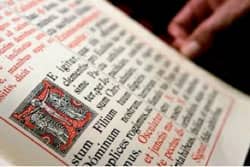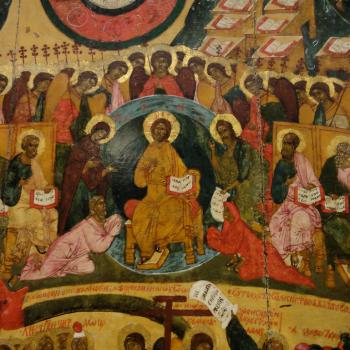(This week's column continues a four-part examination of the changes coming to the people's responses when the New Roman Missal takes effect on the First Sunday of Advent, November 27. In Part III, we consider the Sanctus and the Mystery of Faith, or what we've known as "The Memorial Acclamation." See also Part I and Part II.)
 Some of the most recognizable tenets of Vatican II were the changes in the celebration of the Mass. At the core of those changes was the call for dynamic participation in the Mass on the part of the laity. That same call applies as we face the changes in the New Missal. Yet, it is important to remember that the New Missal does not present a new rite for the Mass, rather, an updating of the English translation following the new official Latin translation promulgated several years ago.
Some of the most recognizable tenets of Vatican II were the changes in the celebration of the Mass. At the core of those changes was the call for dynamic participation in the Mass on the part of the laity. That same call applies as we face the changes in the New Missal. Yet, it is important to remember that the New Missal does not present a new rite for the Mass, rather, an updating of the English translation following the new official Latin translation promulgated several years ago.
Mother Church earnestly desires that all the faithful should be led to that fully conscious, and active participation in liturgical celebrations which is demanded by the very nature of the liturgy. Such participation by the Christian people as "a chosen race, a royal priesthood, a holy nation, a redeemed people (1 Peter 2:9; cf. 2:4-5), is their right and duty by reason of their baptism.
(Sacrosantum Concilium, Constitution on the Sacred Liturgy, par. 14, from the Documents of Vatican II)
One of the best ways we can achieve full, conscious, active participation is by engaging mind and heart as we pray. The more freely we enter into prayer, the better we participate.
The implementation of the New Roman Missal brings a fresh opportunity to reflect on the Mass and reawaken our participation in it. The coming changes to the people's responses may indeed distract us from that depth of participation during the first few weeks of Advent. But, once we understand the meanings behind the changes, and our tongues conform to the newer prayers over time, we may be led to a deeper and renewed connection with the Lord.
Will there be some awkward moments in the first few weeks? No doubt. But difficulties can be mitigated as we become more familiar with the coming changes.
The Sanctus ("Holy, Holy, Holy")
Current translation:
Holy, holy, holy, Lord God of power and might,
Heaven and earth are full of your glory.
Hosanna in the highest.
Blessed is he who comes in the name of the Lord.
Hosanna in the highest.
New Translation:
Holy, Holy, Holy Lord God of hosts.
Heaven and earth are full of your glory.
Hosanna in the highest.
Blessed is he who comes in the name of the Lord.
Hosanna in the highest.
There seems to only be the slight change in the opening line of the Sanctus, where the word "hosts" replaces the phrase "power and might."
This prayer comes at an important transition within the Mass, preparing our hearts to join with the priestly offering of the Eucharistic prayer. This hymn uses the thrice holy Hebrew superlative, praising the infinite and almighty God in heaven. The New Missal's switch to using the word "hosts" more accurately reflects the Scriptural origins of this prayer.
This hymn to God is taken directly from a heavenly vision from the prophet Isaiah (See Is 6:3). What's more, the vision vividly describes not just some angels present at the heaven liturgy; the word "host" refers to an army of angels lifting praises to God.
"Host," you may recall, also references the many angels who lit up the sky with their praises on the first Christmas night when Jesus was born in Bethlehem. The shepherds were greeted by a multitude of "the heavenly host (Lk 2:13)"
This simple change in wording conveys powerful imagery and the truth of what is dynamically present to us in the liturgy.





